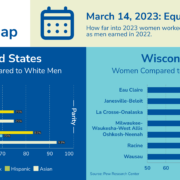Where Have All the De Novos Gone?
Barriers to entry, reasons to overcome them, and why it's important for the industry
In 2005, the FDIC reviewed 299 applications to start new banks (237 were approved). From 2009 to 2016, they approved just five. Meanwhile, the U.S. economy in general has recovered from the financial crisis of 2008 and subsequent recession, with employment levels back to their 2005 numbers and housing markets back to booming. So, where have all the de novos gone? "It's a combination of factors," said Attorney James Sheriff, partner at Reinhart Boerner Van Deuren, s.c. "It's not a simple, easy answer." The credit crisis alone did not cause the current dearth in de novos, but its lingering effects have created several barriers to entry that discourage the formation of new banks. "This didn't go from a lot to a few; it went from a whole bunch to nearly none. That's very telling," said Andy Guzikowski, Attorney and Shareholder at von Briesen & Roper, s.c. "It's all related to barriers to entry, both real and perceived."
Barriers to Entry
Compliance | One obvious headwind to starting up a bank is the current regulatory environment, which is far more onerous than it was a decade ago. "Practically speaking, the regulatory environment is much more complex with regard to de novo banks," said Tim Kosiek, CPA, partner at Baker Tilly Virchow Krause, LLP. "There's still overlay from the credit crisis and recession." Unfortunately for de novos—which are almost always small community banks, at least at first—community banks shoulder a disproportionate regulatory load in today's industry, and the costs of that add up quickly. "Community banks in particular need to spend more time and money on compliance than they ever have before," Sheriff explained. There have been recent indications, however, that the federal regulatory agencies are willing to compromise in order to foster new banks. "The regulators are always collaborative, very willing to meet and spend time and provide resources to answer questions," said Pete Wilder, attorney and shareholder at Godfrey & Kahn, S.C. He pointed out that the FDIC has been holding meetings on how to encourage de novo activity and has updated its manuals for applications.
Capital | Another commonly cited barrier to entry is today's higher capital requirements. "The capital requirements today are significantly greater than they were 20 years ago," said Mark Koehl, partner at Wipfli LLP. "That's certainly a big hurdle." In the de novo heydays of the late 1980s and early 1990s, a group of investors could start a bank for $6M. Today, most estimates hover around $15-$20M. However, that number can vary depending on the new bank's specific circumstances. "There is a lot of misinformation out there related to capital," Wilder explained. "The regulators don't take a one-size-fits-all approach." He says DFI and FDIC both determine capital requirements based on the new bank's intended market, products and services, and growth strategy.
ROI | The general decline in bank profitability since the crisis is another barrier to entry for potential new banks; it means lower returns for investors. "The returns available in the banking business are measurably reduced compared to what they were prior to the credit crisis," said Kosiek. "We're in a measurably different landscape when it comes to economic reward for entering the industry." He also pointed out that the amount of time it takes for a de novo to reach "critical mass" and begin generating returns for its investors is much longer today than it used to be—7-10 years instead of 5-7. The current prolonged low interest rate environment compounds this problem, lengthening the time it takes for a nascent bank to become profitable. "Investors hope a bank will become profitable within two years, and with the interest rate environment we're in it's difficult for investors to see banks making money," Sheriff explained. This less-than-appealing timeline plus the current regulatory environment makes purchasing a bank much more attractive to investors than starting one from scratch. "It's much easier for a group of people who want to start a bank to buy a bank than to form a new one," said Sheriff. "It's faster, and the process of getting approval is far less complicated. You also don't have to go find talent, in many cases."
Talent | The cost of talent is another factor that gives potential de novos pause. "There's still a bit of malaise from the crisis, where the entrepreneurial spirit has been dampened," said Wilder. That lack of leadership combined with the higher prices commanded by experienced compliance and lending professionals makes building a staff difficult. "There's a notably lower supply of high-quality bank talent on the marketplace in comparison to what you had 10-20 years ago," said Kosiek. "There are just fewer people out there who think banking is the right place for their career."
Competition | Finally, the competitive environment in the financial services industry is wider and more complex than it used to be, for a variety of factors. First, small businesses no longer feel underserved when local banks merge with larger institutions, according to Koehl. "Many larger institutions have done a good job serving communities, and fintech companies are also helping to fill in the gaps," he explained. "In addition, millennial business owners don't necessarily want the same level of relationship development." The more relaxed regulatory environment and exciting startup culture makes investing in fintech companies more attractive to most investors than a de novo community bank. "There are other options within the banking industry and within the financial services industry that are more appealing to the investor and a better answer for customers and business owners," said Kosiek.
Impact on the Industry
Wisconsin is fortunate to have a diverse, thriving financial services industry, so the Badger State hasn't been as heavily affected by the national lack of de novo activity as states with fewer banks. However, underserved markets are typically where de novo activity happens, so they are the first to feel the impact when it doesn't. "Most important is the availability of credit to rural areas," Guzikowski explained. "Larger banks can achieve that true community contact, character-based lending if they have the right people, but that's specifically what de novos and community banks are designed to do." In rural states like Wisconsin, merger activity without de novo activity often results in fewer financing options for businesses and consumers outside of metropolitan areas. "If the current trend continues without the ability to encourage de novos in the future, we're at risk of having a good chunk of our state where the local economy suffers because of a lack of community bank presence," said Koehl.
The lack of new banks also impacts M&A activity. "It deprives the industry of new opportunities for growth," Guzikowski said, explaining that many investors consider growing through acquisition and then selling a bank to be a good exit strategy. The lack of de novos means there are fewer acquisitions to be made, making that strategy more difficult. Instead, many investors see purchasing an existing bank as a better opportunity. "If you're interested in the banking industry from the investor standpoint, dropping your money into a de novo is not as appealing as investing in an existing franchise, enhancing it and getting ready for acquisition by a larger enterprise," said Kosiek. According to Koehl, another major factor is that acquired banks used to have younger management teams who wanted to stay in the industry and did so by starting their own bank. "Today, there's still a lot of M&A, but it's often with banks with older management teams who are looking for an exit strategy," he explained.
Finally, startups—in any industry—are the most likely source of excitement and innovation. "Traditionally new banks have more innovative ideas," said Sheriff. "They're looking to make a statement." New entrants to the market can prevent other banks from stagnating. "For the industry overall, having a few new banks pop up here and there means there's more room for new ideas, new products, and more creativity and excitement in the industry," said Wilder.
Looking Forward
While de novos have been rare over the past decade, there are signs the tide is turning. In the final quarter of 2016, the FDIC approved two new bank charters. In April 2016, FDIC Chairman Martin Gruenberg announced the reduction of the period of heightened scrutiny for newly chartered institutions from seven years to three, the same level it was before the financial crisis. Since then, FDIC has published a handbook for prospective de novo applicants and held outreach meetings on the topic. Other federal regulators are taking steps to reduce some of the friction in the de novo process, as well. "The OCC in particular has recognized that new banks are the lifeblood of a robust banking industry," said Guzikowski. Acting Comptroller of the Currency Keith Noreika has gone so far as to suggest the OCC be granted authority to approve de novo applications. Considering these ongoing efforts, Guzikowski suggests the next step is test cases. "With the easing of the interest rate environment, what the regulators need now are more applications so they can start putting some of their initiatives into practice," he explained.
In combination with this (slightly) softening regulatory environment, Wisconsin's robust, steady economy could be fertile ground for new banks. "Our economy tends to be pretty stable compared to the big swings you see on the coasts, so it's a good environment for banking," said Wilder. Since 1990, Wisconsin has had 33 de novos and only three of them failed, while on average the new banks turned a profit within six quarters. The recently announced Foxconn development planned for the southeastern corner of the state also brightens prospects for potential new banks. "If all that comes to fruition, it could be an opportunity," said Koehl. "Community banks, whether they're in existence today or a de novo, they're always driven by how their local economy is doing. So, if you have a vibrant economy in a local market that doesn't have a community bank, that's an opportunity for a de novo."
Baker Tilly Virchow Krause, LLP and Wipfli LLP are WBA Silver Associate Members.
Godfrey & Kahn, s.c. and von Briesen & Roper, s.c. are WBA Bronze Associate Members.
By, Amber Seitz




